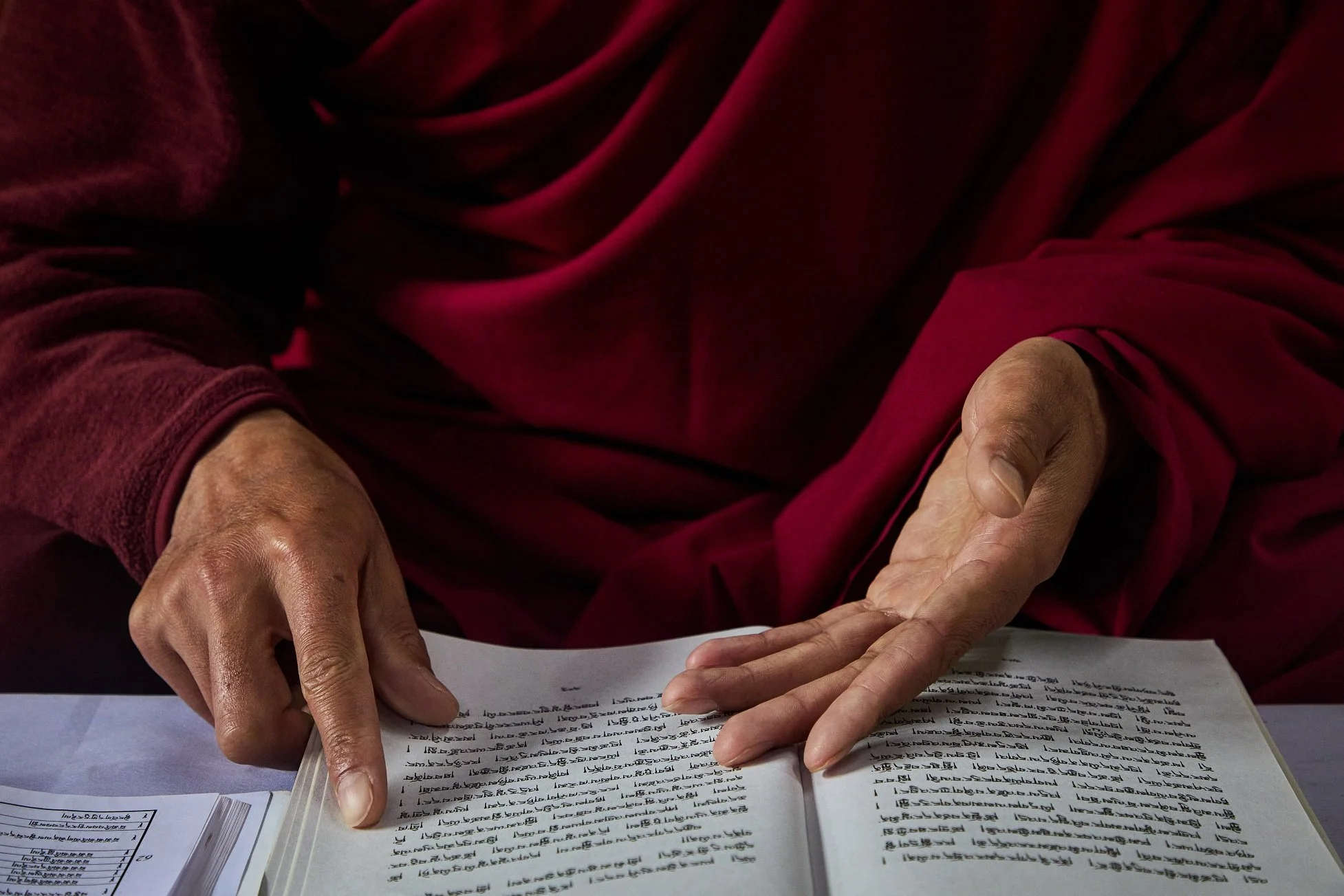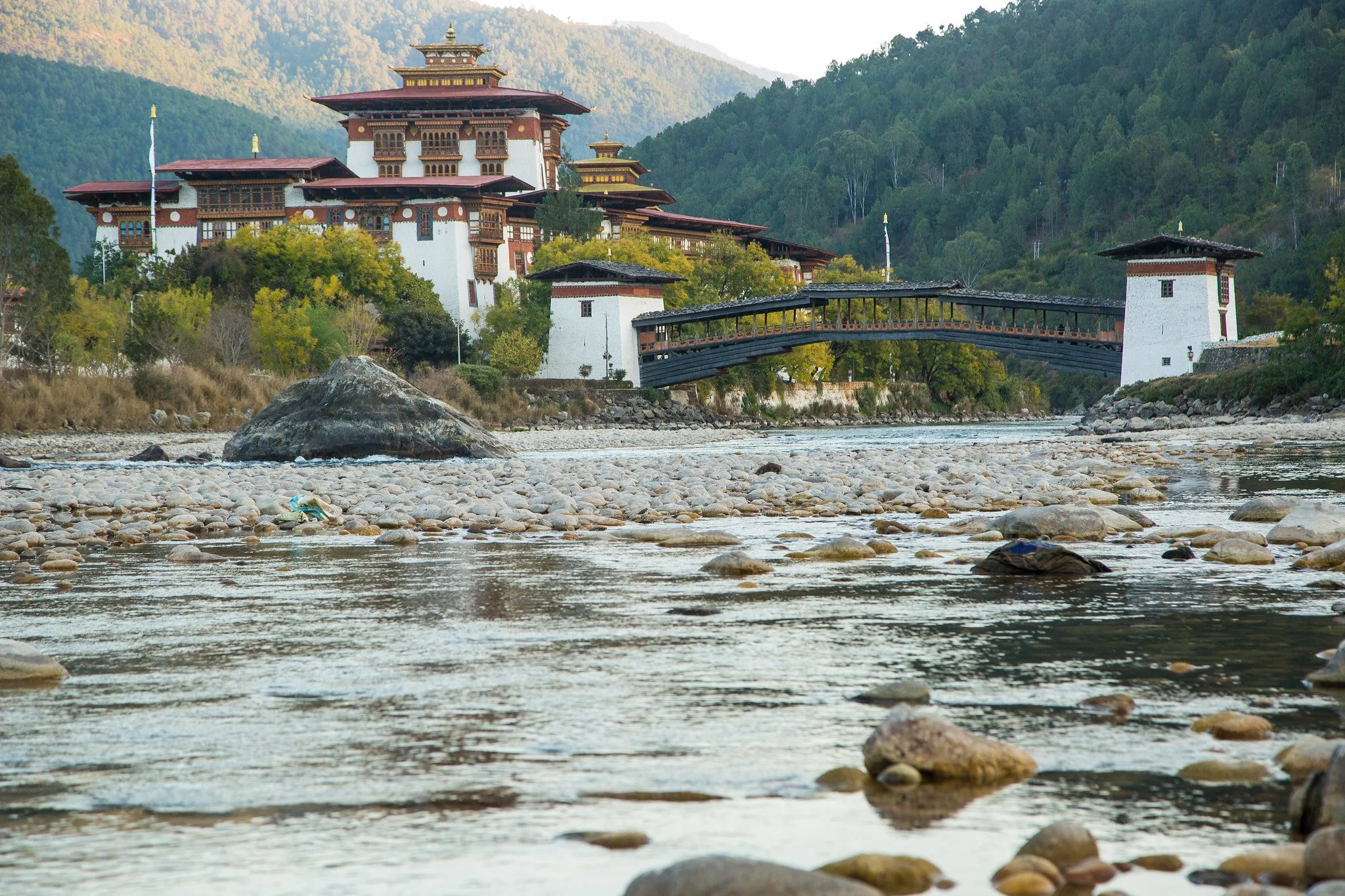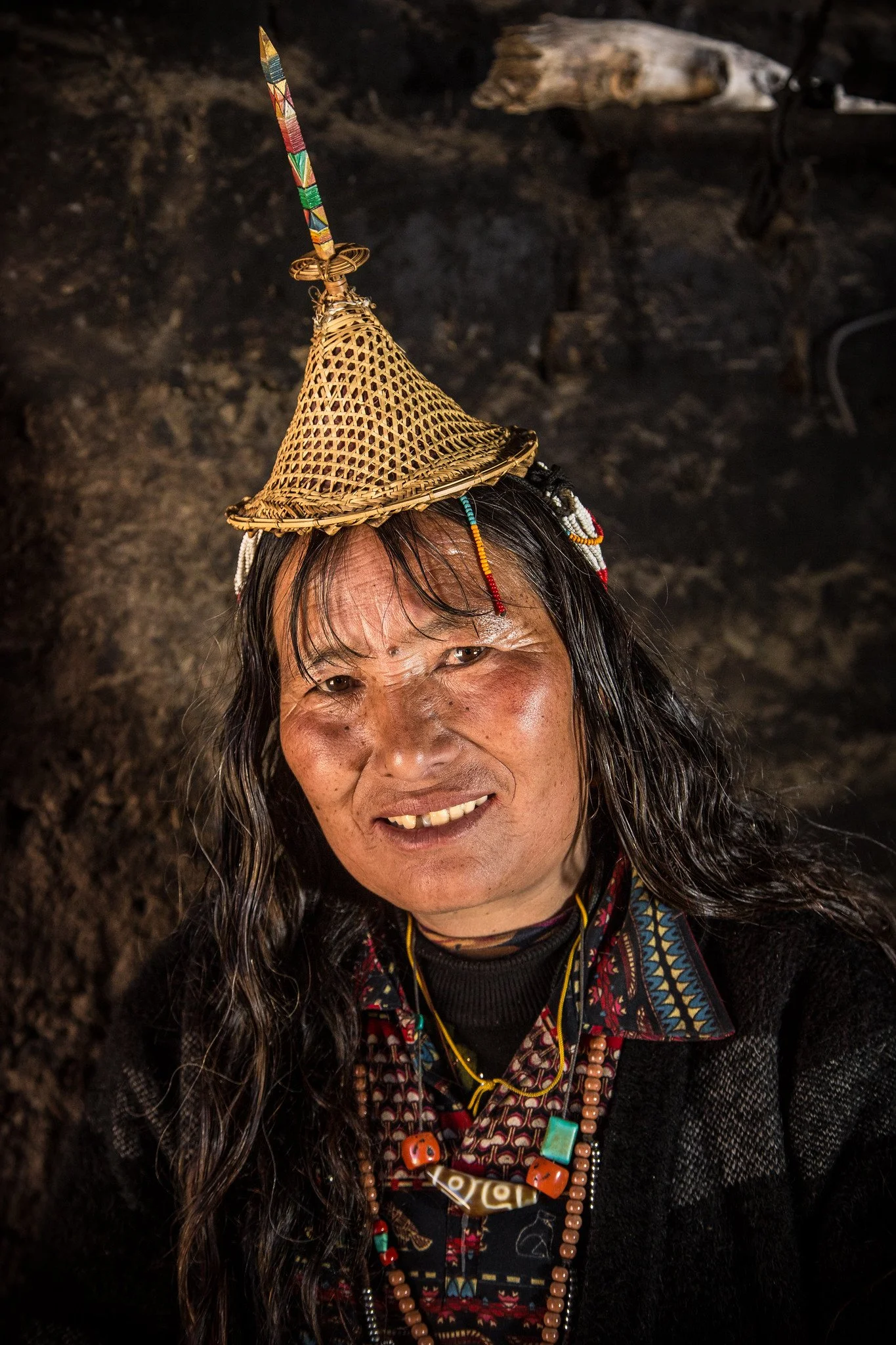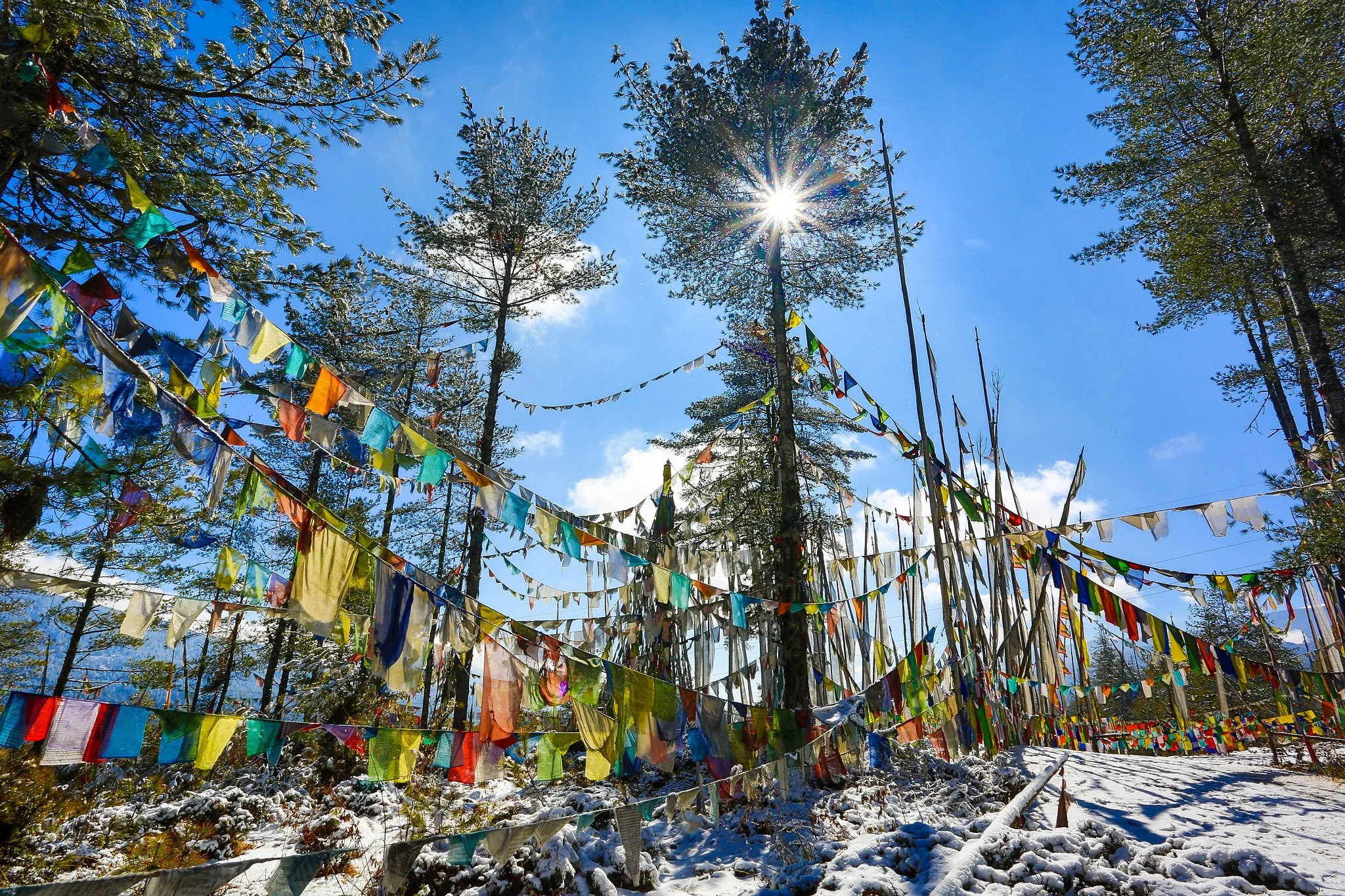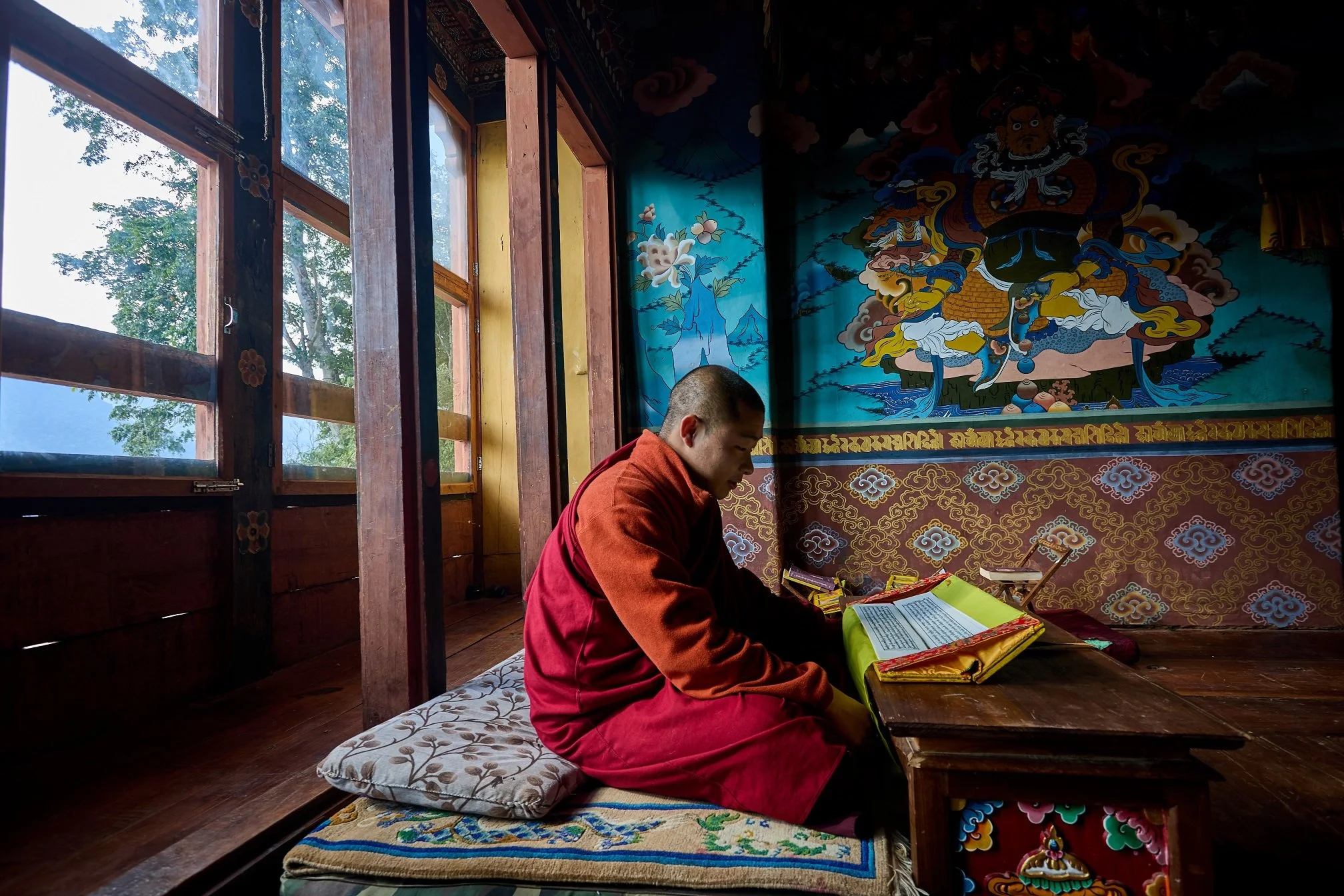Hidden Bhutan Itinerary
Day 1: Arrive in Paro
Most flights into Paro International Airport arrive in the morning. You will be met at the airport by your local guide and driver and taken to your hotel for lunch and a short rest.
In the afternoon we will visit the spectacular, riverside Paro Rinpung Dzong, which means the fortress on heap of a jewels. Built by Zhabdrung Ngawang Namgyel in 1646 it’s one of the most spectacular dzongs in the country and a brilliant opening to your Bhutan adventure. If you’re not too tired then after the dzong we will head to the 17th Century Taa Dzong (watch tower) which today contains the superb national museum.
Day 2: Haa Valley
Overlooked by most visitors to Bhutan, the wonderful Haa valley, which is just a 2.5hr drive west from Paro, is one of our personal favourite places in Bhutan. The valley contains all that is good about Bhutan. There’s the spectacular mountain scenery – getting to the Haa Valley involves crossing the Chele la Pass (3,988m/12,402 ft); the abundance of monasteries filled with religious treasures, beautiful farming countryside, cliff side chapels laced in magic, fabulous hiking and some of the best homestay-style accommodation in Bhutan. Botanists will also appreciate the chance to see the elusive blue poppy which is unusually common in this valley.
We will visit the ancient white monastery and nearby black monastery as well as the superbly situated Shelkar Drak, a cliff side retreat visited by few foreigners.
At the end of a thrilling day, we will drive up towards the head of the valley to our superb heritage homestay. This is a good place to try a traditional Bhutanese hot stone bath – a great way to relax travel weary muscles.
Day 3: Haa Valley Hiking
After a big Bhutanese breakfast it’s time to put on your hiking boots as we hit the trail on the recently developed Haa Panorama Hike. This 11km (4.5hrs) hike weaves through misty, old-growth conifer forests and across a quiet side valley where yaks might be seen to eventually reach the Yangthong Goemba. One of the most important monasteries in the valley we will see if we can spot some of the mermaids said to live in the pool just outside. Failing that, there are always plenty of friendly monks here to chat too. It’s then just a short, steep hike to the extraordinary Juneydrak Hermitage. This tiny retreat sticks like a gecko to the sheer cliff face while the surrounding caves and huts are used by nuns engaged in deep meditation that can sometimes last for years on end. Our guide will explain the fascinating story behind the hermitage. it’s a story that sounds like it has been lifted straight out of a fairytale.
At the end of a great days hiking and exploring we head back to our heritage homestay for the night.
Day 4: Haa – Paro - Thimpu
Leaving the Haa Valley we drive through fabulous mountain scenery for about four to Thimpu, the little capital of Bhutan. On the way we stop again at the Chele la pass for a short and easy (two hour) hike to the Kila Nunnery. This large complex, which stretches along the cliff face, consists of several chapels and retreats as well as the nuns accommodation. Many of the nuns here spend long periods of time in meditation or chanting and reading the Buddhist scriptures. Those not in mediation though always offer visitors a warm welcome – don’t be surprised if we are invited to sit down and drink tea with the nuns. It’s a great opportunity to learn a little about their lives.
If time allows we will also stop at another cliff side chapel complex, Dzongdrakha Goemba. Although this complex is close to Paro and sometimes described as a mini Tigers Nest, it receives very few foreign visitors, which is all the better for us. Ninth century Tantric Buddhist master, Guru Rinpoche is said to have battled demons here during his many visits to Bhutan. During our last research visit (early 2025) much of the complex was undergoing renovations but it’s still worth a visit just for the views down towards Paro.
We will arrive in Thimpu in the early evening to check into our hotel.
Day 5: Thimpu Valley & hike to Dodeydra
Today will be a special day as we take you to experience a side of Bhutan few foreign visitors get to experience.
The day starts at with an early morning visit to the 51meter high, bronze Shakyamuni Buddha statue from where you can get a good view over Thimpu.
Dropping back down into the Thimpu valley we stop at the Tibetan style National Memorial Chorten. Built in the 1970’s to commemorate the third king it’s visited by many pilgrims throughout the day who make a clockwise kora (circuit) of the stupa while chanting and spinning prayer wheels.
Next is a visit to the 12th Century Changangkha Lhakhang, which is another busy pilgrimage site. Many new parents come here to have their baby blessed, an auspicious name chosen by the monks and an astrological reading done. You can also get your own astrological chart done here.
After lunch we head to the spectacular 17th Century Trashi Chhoe Dzong. The fortress like structure dominates the Thimpu valley and contains the dragon throne room of the king of Bhutan, the office of the Je-khenpo (chief abbot), and other government agencies. It’s also used as summer residence of the monk body.
At the end of the afternoon we hike (2hrs) to the Dodeydra Monastery, a 17th Century complex where the main temple is pushed up against a distinctive rock slab. The complex spreads along the hillside and there are many monks resident here. And these monks are going to be our hosts for the night because we will be actually sleeping at the monastery and eating with the monks. You will also get to attend the dawn prayer sessions when the monks fill the incense soaked prayer hall with chanting. The accommodation here is simple but adequate, but it’s a real once in a life time experience and not something that many visitors to Bhutan can claim to have done!
Overnight at Dodeydra monastery
Day 6: Thimpu
After breakfast with the monks and more exploration of the monastery complex we hike back down to the waiting car and then head to the northern edge of Thimpu and the Pangri Zampa, a large 16th Century temple that today houses the College for Astrology. Astrological readings are of great importance to all Bhutanese. Every child is given a life reading shortly after their birth and people visit an astrologer at least once a year and before embarking on any major life event. This college trains up the most talented monks to be astrologers and during a visit you can, if you wish, get your own reading done.
After lunch we set out on another short hike. This trail takes us to the hillside Tango Goemba, at the northern end of the Thimpu valley. Founded in the 12th Century (though the current structure is more recent), it’s now a very important Buddhist university. Getting there involves a 45min hike (one-way). Next we walk to the Cheri Goemba on the opposite side of the valley (45min hike) which is one of the oldest monasteries in the country. Neither of these monasteries receive many foreign visitors yet are two of the more interesting in western Bhutan.
We return back to Thimpu and our comfortable hotel for the night.
Day 7: Thimpu - Punakha
After breakfast we check out of the hotel and drive for about three hours to the Punakha valley (2.5hrs). En route we stop over at the Dochu la pass (3100 meters) to enjoy the spectacular views of the snowcapped Himalayan Mountains and explore the 108 stupas here constructed to commemorate the 108 Bhutanese who lost their lives in a brief 2005 war against militants from Assam (India) who has established camps in Bhutan. We also do a short (3hrs rtn) and easy hike through tangled rhododendron and conifer forests to the remote Lungchutse Goemba which was founded in the 18th Century by religious treasure hunter, Tashi Barwa. The serene and rarely visited goemba is situated on a hill with commanding mountain views and is home to a handful of monks.
We then drive the corkscrewing road down to Punakha. Much lower than anywhere else we have so far visited, the climate here is sub-tropical and there is an abundance of fruit and flowers, as well as good birdwatching. Framed by jacaranda and bougainvillea trees, the riverside Punakha dzong is one of the iconic sights of Bhutan. Punakha was once the capital of Bhutan and the Punakha dzong, which, poetically, means the fortress of Great Bliss, was built by 1673 by Zhabdrung Ngawang Namgyel (the first spiritual and political leader of Bhutan) to commemorate the defeat of Tibetan invaders. Located on an island between two rivers Pho Chhu and Mo Chhu (literally meaning male and female rivers), the massive dzong is one of the most beautiful and impressive in the country. The building has hosted many significant events in Bhutanese history, such as the crowning of the first king of Bhutan and the wedding ceremony of the current king. Many important religious ceremonies are still held here.
We overnight in a comfortable Punakha valley hotel.
Day 8: Gasa
Today we head right up beyond the northern head of the valley and way off the beaten tourist track to the small mountain town and hot springs of Gasa (3hrs drive). The highlight of this remote area is the impressive mountainside dzong, which was constructed in the 17th Century as a bulwark against the attacks from nearby Tibet. The dzong contains many important sacred relics and the whole area around is awash in legends with locals saying that the entire landscape has the appearance of Tsheringma (Goddess of long life). As well as the dzong we will visit the hot springs which are famed across Bhutan for their health benefits. Many sick and elderly pilgrims come here to bathe in the waters (you can join them if you wish). As well as the classic tourist sites, Gasa is simply a delightful place to wander around and enjoy chatting with the local farmers and herders.
We overnight in a simple guesthouse.
Day 9: Gasa - Laya and the Himalaya
Far from the mainstream of Bhutanese life and overlooked by a wall of mountain peaks, including Tsenda Kang (6481m), the village of Laya is the highest (3820m), and most northerly, permeant settlement in Bhutan. No roads connect the village to the rest of the country (though road construction is underway) which means that Laya, which is home of the yak herding Layap people, is something of a world apart. Living a very traditional lifestyle, the Layap, who are known for the women’s distinctive woven hats, consider their homeland to be a beyul, or hidden Buddhist paradise.
Our journey to this distant outpost of Bhutan involves a two hour drive from Gasa along a bumpy road and then a moderate hike (3hrs). On arrival we will explore the village and meet the people.
Each October (23rd and 24th) one of the country’s most popular festivals, the Royal Highland Festival, takes place on the pastures outside of Laya. The festival features dances, parades, highland games and a livestock show. It attracts people from across Bhutan, including some of the Royal Family.
We will overnight in a simple homestay guesthouse.
Day 10: Laya and the Himalaya
Today is devoted entirely to exploring the alpine pastures and highland landscapes surrounding Laya. A moderate day hike will lead us to a high-altitude lake in a frozen rocky bowl to the north of the village. On clear days there are spectacular views over the Himalayan giants that separate Bhutan from Tibet. We will also visit some of the farmsteads around the fringes of the village. The walking can be tailored to be as hard or as easy as you like.
Overnight in simple homestay guesthouse.
Day 11: Laya to Punakha
After a final breakfast with out Layap hosts we start the long journey back to the rest of Bhutan. A 2-3hr hike brings us back to the road head and then after a 3-4hr drive we arrive back in Punakha, where the relative heat will likely seem a luxury after the previous nights at altitude. If time allows, we will explore some of the lesser known temples around the Punakha valley.
Overnight in a comfortable hotel in Punakha.
Day 12: Punakha to Paro
The morning is spent exploring more sights around Punakha starting with a short walk of about an hour to the Khamsum Yulley Namgyel Chorten stupa. It’s a beautiful walk through the pine trees and past little terraced fields of rice, to this modern, multi-layer stupa with glorious valley views.
Jumping back in the car we head down the valley a short way to the Chimi Lhakhang, otherwise known as the fertility temple. The site of the temple is a pleasant 30-minute walk through mustard and paddy fields. Standing on a picturesque hilltop the Lhakhang is visited by couples hoping to conceive. Inside the walls of the Lhakhang are beautiful frescoes depicting the colourful life of 16th Century Lama Drukpa Kuenley. Otherwise known as the Divine Madman, he shocked the Buddhist clergy with his rather controversial methods of Buddhist teaching, which included the consumption of large quantities of alcohol and blessing (a lot of!) women by copulating with them. Needless to say, he quickly became a hit with the average Bhutanese person and he’s still one of the most popular saints in Bhutan today. Those wishing to test out the powers of the temple have to circumnavigate the building while carrying a very large and heavy phallus before being hit over the head with a large wooden phallus.
Our bizarre encounter over we pause for lunch before driving to Paro (3hrs). Overnight Paro.
Day 13: Bumdrak Hike
After a relaxing breakfast we drive a short way to the Sangchen Choekor Shedra, an 18th Century Buddhist College with several hundred students studying Buddhism and secular studies. Some of these students will likely show us around but equal reward is just taling in the stunning view of the Paro valley. It’s a view that’s made even more impressive when a plane glides right past the collage on its final descent into the main international airport!
After exploring the college we begin the exciting hike (4-5hrs; moderate) to the incredible cliffside Bumdrak Monastery (3900m). The monastery complex, which is squeezed up against the rock face, is said to be built on the site where 100,000 fairies gathered. For those with the energy you can carry on up above the monastery a short way to a small summit (4200m) with a sky burial site. Traditionally Tibetan Buddhists living in highland areas of the Himalaya are not buried or cremated by their corpses are chopped up and fed to the vultures and crows. There were two reasons for this. The first, and entirely practical one, was because the half frozen, rocky and treeless landscape prevented burials or cremations. The second reason is that it demonstrates the Buddhist belief in the impermanence of the physical body and is a final act of generosity by providing food to birds. Today, sky burials in Bhutan are much less common than they once were but if one is taking place when we visit we should respect the privacy of those in attendance.
After exploring around Bumdrak we will set up our tents and cook dinner under a million stars.
Day 14: Bumdrak to Taktshang Monastery (Tigers Nest) Hike
Your final full day in Bhutan is a big one! After an early campsite breakfast we hike slowly downhill to the spectacular Taktshang monastery, more commonly known as the Tigers Nest Monastery. Before we get there though our trekking route takes us past a couple of other smaller, little visited chapels filled with the mist of magic. For many people, Taktsang is the reason they came to Bhutan in the first place, and approaching from this angle – far from the crowds following the main trail up to it – offers a unique perspective on it. The 8th Century (much rebuilt since then) cliff ledge monastery plays a big part in Bhutanese culture. This was one of the places where the saint, Guru Rinpoche (Padmasambhava) meditated with his consort Khandro Yeshey Tshogyal. It is believed that Guru flew on a female tigress in pursuit of a demon which he subdued at the site. It is one of the holiest sites in Bhutan and the most important cultural icon of the country.
Later in the afternoon we follow the main hiking trail for an hour back to the valley floor from where we drive back to the hotel. Our last dinner is taken at a farmhouse with a traditional Bhutanese meal. You may also appreciate a hot stone bath to sooth hike weary muscles.
Overnight in a Paro hotel.
Day 15: Departure
Almost all flights leave Bhutan in the early morning so after an early breakfast your guide and driver will take you to the airport for your flight home or to further adventures in India or Nepal. And, don’t forget that Samgai Journeys offers a range of exciting tours and treks in both of these countries.





